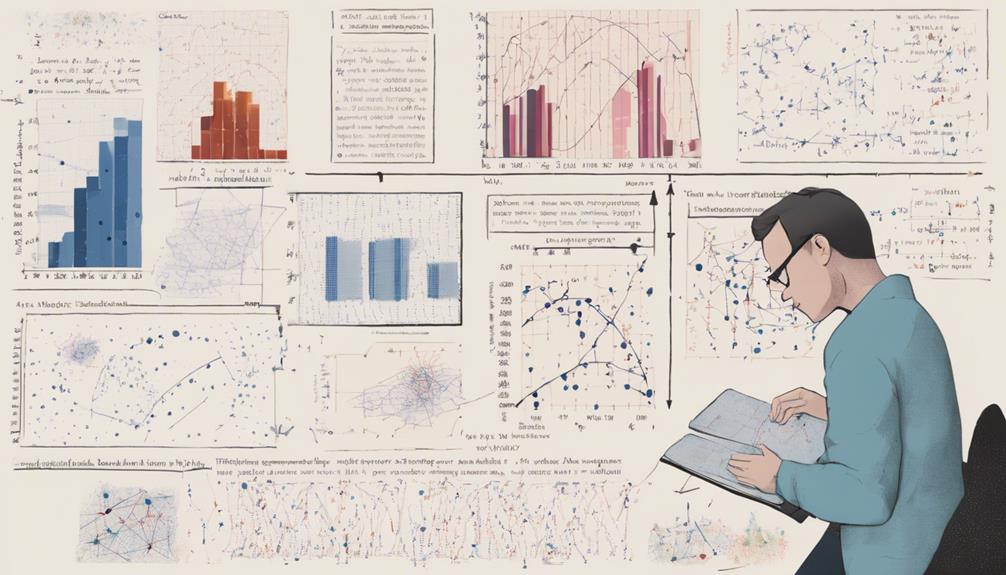A Handbook of Statistical Analyses Using R by Torsten Hothorn – Summary and Review

'A Handbook of Statistical Analyses Using R' by Torsten Hothorn is a comprehensive guide for statistical analysis using R. It is suitable for both beginners and experienced analysts. The book offers clear explanations and practical insights, making it a valuable resource for anyone working with data.
This handbook covers a wide range of statistical techniques, from basic concepts to advanced methods. It also includes numerous examples and exercises to help readers apply the techniques in practice. Overall, it is a useful tool for anyone looking to enhance their statistical analysis skills using R.
Key Takeaways
- Expertly combines theory with practical examples for easy understanding.
- Enhances analytical skills through hands-on problem-solving and data visualization.
- Empowers readers to apply statistical analyses effectively in real-world scenarios.
- Users value clear explanations, practicality, and comprehensive coverage for skill enhancement.
Author Background
Torsten Hothorn, the author of 'Statistical Analyses Using R,' brings a wealth of experience and expertise to the field of statistical analysis. With a robust academic background, Hothorn holds a Ph.D. in Statistics and has made significant contributions to the domain of data analysis. His research focuses on developing statistical methodologies and tools to address complex real-world problems, making him a respected figure in the statistical community.
Hothorn's academic credentials include a tenure as a professor at the University of Zurich, where he's mentored numerous students and researchers, shaping the next generation of statisticians. Through his extensive publication record in top-tier journals, he's demonstrated his proficiency in both theoretical statistical concepts and practical applications using software like R.
Book Overview
With an extensive background in statistical analysis and a reputation for developing innovative methodologies, 'Statistical Analyses Using R' offers a thorough guide to utilizing R software for practical data analysis purposes. This detailed handbook covers various statistical techniques, including data visualization techniques and hypothesis testing methods. By combining theoretical explanations with practical examples, readers can grasp complex statistical concepts easily.
To provide a glimpse into the content of the book, the following table summarizes some of the key aspects covered in 'Statistical Analyses Using R':
| Topics | Description |
|---|---|
| Data Visualization Techniques | Learn how to visually represent data for better understanding and analysis. |
| Hypothesis Testing Methods | Explore different methods to test hypotheses and draw meaningful conclusions. |
Statistical Concepts Covered
Covering a range of statistical concepts essential for practical data analysis, 'Statistical Analyses Using R' explores key methodologies and techniques for effective statistical modeling. The book delves into various fundamental concepts, including hypothesis testing, regression analysis, data visualization, and model building. It provides a thorough understanding of these important statistical techniques, empowering readers to make informed decisions based on data-driven insights.
- Hypothesis Testing: 'Statistical Analyses Using R' offers an in-depth exploration of hypothesis testing, allowing readers to assess the validity of assumptions made about a population parameter.
- Regression Analysis: Through detailed explanations and examples, the book guides readers on how to use regression analysis to understand relationships between variables and make predictions.
- Data Visualization: The importance of visualizing data effectively is emphasized, enabling readers to communicate findings clearly and intuitively.
- Model Building: Readers are introduced to the process of building statistical models, equipping them with the tools to extract meaningful information from complex datasets.
R Packages Utilized
Utilizing a diverse array of R packages enhances the statistical analyses discussed in 'Statistical Analyses Using R' by Torsten Hothorn, elevating the depth and breadth of data exploration and modeling capabilities.
For data visualization, packages like ggplot2 and plotly offer compelling ways to represent complex datasets graphically, aiding the interpretation of trends and patterns. These tools provide interactive and aesthetically pleasing visualizations that can uncover hidden insights within the data.
Concerning regression analysis, packages such as lmtest and car facilitate the implementation of various regression models, hypothesis testing, and diagnostics. They empower researchers to conduct thorough regression analyses, assess model assumptions, and interpret results accurately.
Practical Applications
In the domain of statistical analyses, practical applications serve as the bridge between theory and real-world insights.
By engaging in hands-on problem-solving exercises, individuals can sharpen their analytical skills and gain a deeper understanding of how data analysis unfolds in practice.
Through real-world data analysis, users of R can transform abstract concepts into tangible solutions, fostering a dynamic learning experience.
Real-World Data Analysis
Real-world data analysis in practical applications reveals the true impact and value of statistical methodologies in decision-making processes. When delving into the world of real-world data analysis, individuals often encounter a myriad of challenges and opportunities, showcasing the dynamic nature of data-driven decision-making.
Some key aspects to explore in this domain include:
- Leveraging advanced data visualization techniques to uncover patterns and insights.
- Implementing predictive modeling strategies to forecast future trends and outcomes accurately.
- Interpreting complex data sets to derive meaningful conclusions and actionable insights.
- Adapting statistical analyses to unique real-world scenarios, enhancing decision-making capabilities and fostering innovation.
Hands-On Problem Solving
Engaging in practical problem-solving exercises enhances one's ability to apply statistical analyses effectively in real-world scenarios, fostering a deeper understanding of data-driven decision-making. By delving into hands-on activities that involve data visualization techniques, individuals can grasp the power of visual representations in extracting insights and patterns from complex datasets.
Additionally, engaging in predictive modeling exercises allows one to forecast future trends based on historical data, enabling proactive decision-making. Through these practical applications, learners can bridge the gap between theory and practice, honing their skills in interpreting and utilizing statistical methods to solve real-world problems.
Embracing these problem-solving challenges not only enriches one's statistical proficiency but also cultivates a mindset geared towards leveraging data for informed decision-making.
Pros and Cons
When evaluating statistical analyses using R, it's essential to contemplate both the strengths and weaknesses of the software. Understanding the advantages and disadvantages can provide users with a well-rounded perspective on its capabilities.
Strengths and Weaknesses
Boasting a rich array of features, Statistical Analyses Using R by Torsten Hothorn stands out as a thorough resource for both novice and experienced statisticians. When exploring its strengths and limitations, readers will find that:
- Strengths:
- Provides in-depth explanations of statistical concepts.
- Offers practical examples and exercises for hands-on learning.
- Includes code snippets for R programming integration.
- Covers a wide range of statistical analyses commonly used in research.
In understanding the strengths and limitations of this handbook, statisticians can leverage its extensive content while being aware of potential areas that may require additional supplementation or clarification.
Advantages and Disadvantages
Readers can gain valuable insights into the advantages and disadvantages of Statistical Analyses Using R by Torsten Hothorn by examining its strengths and limitations.
The book showcases robust statistical techniques, emphasizing statistical robustness in data analysis. However, it also has methodological limitations that readers should be aware of, such as the need for a solid understanding of statistical concepts.
On the computational front, the book offers efficient methods for analysis, but this might come at the cost of interpretability trade-offs, where complex analyses could be harder to explain.
Understanding these nuances can help readers navigate the balance between computational efficiency and interpretability, ensuring a thorough grasp of the statistical analyses presented in the book.
Positives and Negatives
The exploration of the positives and negatives in Statistical Analyses Using R by Torsten Hothorn sheds light on its practical applications and potential drawbacks.
- Pros:
- Offers a wide range of statistical tools and techniques.
- Allows for reproducible research through script-based analyses.
- Provides a platform for advanced graphical representations.
- Has a strong and active user community for support and development.
While the book presents numerous advantages, it's essential to acknowledge the potential downsides to using R for statistical analyses. Understanding both the benefits and limitations can help users make informed decisions about incorporating R into their analytical workflows.
User Reviews
How do users perceive the statistical analyses presented in 'Statistical Analyses Using R' by Torsten Hothorn? Critical analysis and user feedback shed light on this question.
Users appreciate Hothorn's clear explanations and practical examples that make complex statistical concepts easier to grasp. The book's all-encompassing coverage of statistical techniques commonly used in data analysis resonates well with users. Readers find the step-by-step instructions and R code snippets particularly helpful in implementing the analyses themselves. Many users praise the book for bridging the gap between statistical theory and practical implementation, making it a valuable resource for both beginners and experienced statisticians.
However, some users critique the book for lacking in-depth discussions on certain advanced topics. They desire more detailed explanations and examples for complex statistical methods. Despite this, overall user feedback indicates that 'Statistical Analyses Using R' is a valuable resource for anyone looking to enhance their statistical analysis skills using R.
Conclusion and Recommendations
Having explored user perceptions of the statistical analyses in 'Statistical Analyses Using R' by Torsten Hothorn, it becomes evident that the book's thorough approach garners overall positive feedback, with users valuing its practicality and clarity in bridging statistical theory with implementation.
The key takeaways from the user reviews highlight the following points:
- Practicality: Readers appreciate the practical examples and real-world datasets used throughout the book, making complex statistical concepts more accessible.
- Clarity: The clear explanations and step-by-step instructions aid in understanding and implementing the analyses with ease.
- Relevance: Users find the analyses presented in the book highly relevant to their research or work, enhancing its value as a practical guide.
- Inclusive Coverage: The book's inclusive coverage of statistical techniques caters to both beginners and experienced R users, making it a valuable resource for a wide range of audiences.
Frequently Asked Questions
Can This Book Be Used as a Standalone Resource for Learning R Programming, or Is Prior Knowledge of Statistical Analysis Required?
While some basic statistical knowledge can enhance understanding, this book serves as a standalone resource for learning R programming. Real-world applications and case studies provide practical insights, making it a valuable tool for both beginners and experienced users.
Are There Any Specific Real-World Examples or Case Studies Included in the Book to Demonstrate the Application of Statistical Analyses Using R?
Real world applications in the book include case studies and hands-on examples that offer practical exercises. These exercises demonstrate how statistical analyses using R can be applied in various real-life scenarios for effective learning.
How Does 'A Handbook of Statistical Analyses Using R' Compare to Other Similar Books or Resources Available for Learning Statistical Analysis With R?
In the domain of statistical analysis resources, 'A Handbook of Statistical Analyses Using R' distinguishes itself with a practical approach and real-world examples. While it excels in practicality, it may have limitations in covering more advanced topics compared to other resources.
Are There Any Limitations or Drawbacks to Using R Packages for Statistical Analysis That Are Not Discussed in the Book?
Limitations and drawbacks in using R packages for statistical analysis may include steep learning curves, potential package conflicts, and occasional lack of user-friendly interfaces. However, overcoming these challenges can lead to powerful data analysis capabilities.
Are There Any Additional Resources or Supplementary Materials Recommended for Readers Looking to Further Enhance Their Understanding of Statistical Analyses With R After Completing This Book?
For those seeking to deepen their grasp of statistical analyses with R post-book completion, they are encouraged to explore supplementary resources like online courses and engaging in practical exercises and tutorials to refine their skills further.










